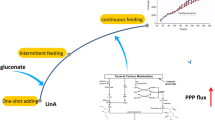Abstract
Optimization of the feeding process for tautomycin production by Streptomyces spiroverticillatus was performed using glucose and/or maleic anhydride. The feeding of glucose was based on the reducing sugar content (lower than 8 g/L) at a cultivation time of 40 h. After addition of 2% (w/v) glucose, the biomass increased from 21 to 28 g/L, and that of tautomycin from 572.06 to 837.6 mg/L. Moreover, 1723.1 mg/L of tautomycin (increased by 201.21%) was obtained by feeding 0.2% (w/v) maleic anhydride solution at a pH between 4 and 7 in the broth. For the experiments in the 15 L fermentor, tautomycin content reached its highest level (1714.7 mg/L), which was 199.7% higher than that of control by feeding both glucose and maleic anhydride.
Similar content being viewed by others
References
Cheng, X. C., T. Kihara, H. Kusakabe, J. Magae, Y. Kobayashi, R. P. Fang, Z. F. Ni, Y. C. Shen, K. Ko, I. Yamaguchi, and K. Isono (1987) A new antibiotic, tautomycin. J. Antibiot. 40: 907–909.
Cheng, X. C., M. Ubukata, and K. Isono (1990) The structure of tautomycin, a dialkylmaleicanhydride antibiotic. J. Antibiot. 43: 809–819.
Chen, X. L., Y. G. Zheng, and Y. C. Shen (2007) Natural products with maleic anhydride structure: Nonadrides, tautomycin, chaetomellic anhydride, and other compounds. Chem. Rev. 107: 1777–1830.
Favre, B., P. Turowski, and B. A. Hemmings (1997) Differential inhibition and posttranslational modification of protein phosphatase 1 and 2A in MCF7 cells treated with calyculin-A, okadaic acid, and tautomycin. J. Bio. Chem. 272: 13856–13863.
Kawamura, T., S. I. Matsuzawa, Y. Mizuno, K. Kikuchi, H. Oikawa, M. Oikawa, M. Ubukata, and A. Ichihara (1998) Different moieties of tautomycin involved in protein phosphatase inhibition and induction of apoptosis. Biochem. Pharmacol. 55: 995–1003.
Chen, X. L., Y. G. Zheng, and Y. C. Shen (2008) Bioassay method for the quantitative determination of tautomycin in the fermentation broth with Sclerotinia sclerotiorum. J. Rapid. Meth. Autom. Microb. 16: 199–209.
Oikawa, H. (2002) Synthesis of specific protein phosphatase inhibitors, tautomycin and tautomycetin toward structure-activity relationship study. Curr. Med. Chem. 9: 2033–2054.
Ubukata, M., H. Koshino, C. Yamasaki, K. I. Fujita, and K. Isono (1997) A pharmacophore model of tautomycin, an inhibitor of protein phosphatases 1 and 2A. J. Antibiot. 50: 801–807.
Magae, J., H. Osada, K. Nagai, M. Yamasaki, and K. Isono (1989) Comparison of the effect of tautomycin and phorbol ester on protein kinase C in A cell-free system. J. Antibiot. 42: 1290–1293.
Ubukata, M., X. C. Cheng, J. Uzawa, and K. Isono (1995) Biosynthesis of the dialkylmaleic anhydride-containing antibiotics, tautomycin and tautomycetin. J. Chem. Soc. 1: 2399–2404.
Li, W. L., J. H. Ju, S. R. Rajski, H. Osada, and B. Shen (2008) Characterization of the tautomycin biosynthetic gene cluster from Streptomyces spiroverticillatus unveiling new insights into dialkylmaleic anhydride and polyketide biosynthesis. J. Biol. Chem. 283: 28607–28617.
Scotti, C. T., C. Vergoignan, G. Feron, and A. Durand (2001) Glucosamine measurement as indirect method for biomass estimation of Cunninghamella elegans grown in solid state cultivation conditions. Biochem. Eng. J. 7: 1–5.
Tsuji, A., T. Kinoshita, and M. Hoshino (1969) Analytical chemical studies on amino sugar II. Determination of hexosamines using 3-methyl-2-benzothiazolone hydrazone hydrochloride. Chem. Pharm. Bull. 17: 1505–1510.
Miller, G. L. (1959) Use of dinitrosalicylic acid for determination of reducing sugars. Anal. Chem. 31: 426–428.
Kim, J. H., K. C. Han, Y. H. Koh, Y. W. Ryu, and J. H. Seo (2002) Optimization of fed-batch fermentation for xylitol production by Candida tropicalis. J. Ind. Microbiol. Biotechnol. 29: 16–19.
Kleist, S., G. Miksch, B. Hitzmann, M. Arndt, K. Friehs, and E. Flaschel (2003) Optimization of the extracellular production of a bacterial phytase with Escherichia coli by using different fed-batch fermentation strategies. Appl. Microbiol. Biotechnol. 61: 456–462.
Author information
Authors and Affiliations
Corresponding author
Rights and permissions
About this article
Cite this article
Chen, XL., Xu, YH., Zheng, YG. et al. Improvement of tautomycin production in Streptomyces spiroverticillatus by feeding glucose and maleic anhydride. Biotechnol Bioproc E 15, 969–974 (2010). https://doi.org/10.1007/s12257-010-0087-y
Received:
Revised:
Accepted:
Published:
Issue Date:
DOI: https://doi.org/10.1007/s12257-010-0087-y




